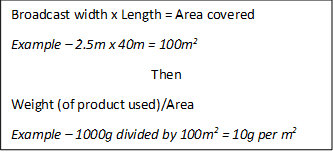Search Our Site
Our Top Sellers
When it comes to calibrating your spreader it can be a daunting task if you are unsure on how to do it. If you get it wrong you could end up either spreading not enough or too much over the lawn which, with both fertiliser and grass seed, it is essential that you get an even layer over the entire lawn. As it is such an important thing to get right, we thought we would put together an easy step-by-step guide to making sure the job is done right each time.
You will need:
